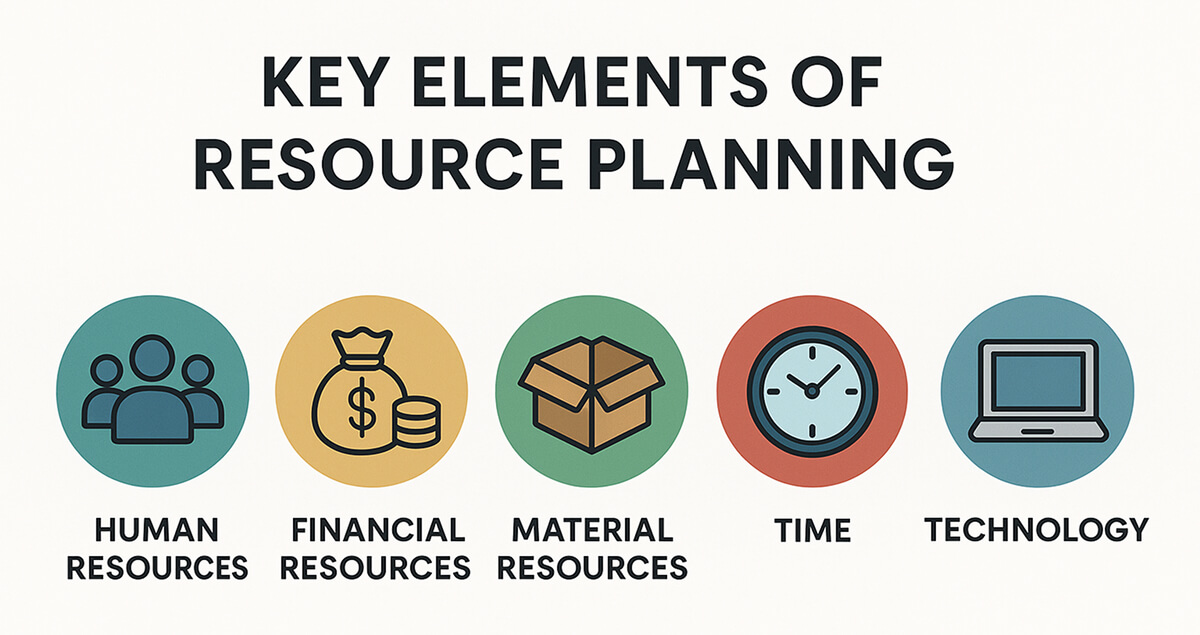Software projects succeed when team capacity meets project demand. Resource planning maps people, budget, infrastructure, and calendar time to work before coding starts. Done early, it prevents budget overruns, developer burnout, and slipped release dates.
What Is Resource Planning?
Resource planning is a lightweight, repeat-forever loop:
- Inventory: list every asset: talent, money, tooling, and hours.
- Match: align each asset to tasks and set guardrails.
- Track: compare plan to real usage every day.
- Adjust: move staff, spin up nodes, or trim scope fast.
In modern software development, the loop integrates into CI pipelines, cost dashboards, and incident data so changes roll in automatically. Good planning keeps scope honest, enables instant rollback, and feeds data back into the next iteration.
Key Elements of Resource Planning

Resource planning can be divided into five main elements.
1. Human Resources
- Match languages, domain expertise, and seniority to backlog items.
- Spread work to avoid urgent on-call alerts.
- Plan reviews and deployments around vacations and public holidays.
2. Financial Resources
- Set soft and hard caps for cloud bills, licenses, and travel.
- Compare planned spend to actual spend each iteration and flag spikes.
- Swap scope or timing before overruns land.
3. Material Resources
- Reserve staging clusters, load-test rigs, and lab devices.
- Retire failing servers before they block deploys or tests.
- Pre-approve policies that add nodes during periods of high traffic.
4. Time
- Put all features on a single, visible timeline.
- Add a small buffer to tasks that depend on others.
- Align with business dates, such as campaigns or audits.
5. Technology
- Automate approvals and allocations with YAML rules.
- Surface live utilization, cost variance, and risk in one place.
- Connect platform engineering tools to HR, finance, and ticketing APIs.
The Resource Planning Process
The resource-planning loop is also a five-step checklist you run every sprint. This helps you keep people, budget, and gear aligned with real project demand.
- Inventory: list current head count, budget, and assets.
- Assess demand: size user stories, capacity targets, and release windows.
- Allocate: map resources to tasks; flag gaps.
- Monitor: compare plan to actual via burndown charts.
- Adjust: reassign staff, spin up nodes, or shift scope.
Common Challenges
Under-allocation
- Too few engineers for the backlog; key tickets stall.
- Velocity drops, deadlines slide.
Over-allocation
- Too many people on one feature.
- Budget burns, but output stays flat.
Conflicting priorities
- Several teams need the same senior reviewer or test rig.
- Work queues stack up; context-switching slows everyone.
Data accuracy gaps
- The plan relies on outdated headcount or cost numbers.
- Bad data → bad forecasts → surprise overruns.
Best Practices for Effective Resource Planning
Following the best practices below will help you move resource planning from paperwork to everyday engineering practice.
Plan with real numbers
- Use historic cycle time and spend, not guesswork.
- Accurate baselines stop both under- and over-allocation.
Update weekly
- Refresh the plan every sprint.
- Small course corrections beat last-minute fire drills.
Share one dashboard
- Expose utilization, cost, and backlog status to all teams.
- Visibility reduces priority clashes and keeps data fresh.
Use feature flags for risk
- Ship behind toggles, so incomplete code won’t block releases if resources shift.
- Flags make schedule slips less painful.
Automate alerts
- Trigger a page (urgent on-call alert) when the CPU load or spend exceeds a set threshold.
- Early warning gives you time to rebalance before users feel pain.
Run brief retros
- After each release, record what planning data was wrong and why.
- Lessons feed back into the next cycle and improve forecast accuracy.
Metrics and KPIs to Monitor
- Utilization rate, the percent of booked time actually spent on planned work.
- Cost variance, the difference between planned and actual spend.
- Throughput per engineer, the number of features or story points closed each sprint.
- Deployment frequency, the number of releases per week, which indicates whether resource flow helps shipping.
Tie these signals back to software engineering resource planning dashboards so leaders can course-correct before pain hits users. Interpreting these numbers matters more than collecting them. A spike in utilization should trigger backlog refinement, while a drop may hint at hidden blockers or tooling friction.
How Resource Planning Powers Platform Engineering
A modern platform in software development is the shared build pipeline, test lab, and observability stack that every app team relies on. Platform engineers must keep that stack ready for commit spikes, canary deploys, and rollbacks. They use engineering resource planning software to:
- Forecast busy weeks: holiday traffic, big launches, audit windows.
- Pre-warm capacity: spin up extra build agents or clusters in advance.
- Automate scaling rules: add nodes or throttle jobs when CPU or spend exceeds a specified threshold.
Clearly defined roles end the platform engineer vs. software engineer argument: platform engineers guard infrastructure; application engineers build features.
Conclusion
Resource planning turns fuzzy goals into concrete, trackable commitments. A simple five-step loop, list assets, match them to tasks, track usage, adjust gaps, and repeat, lets teams identify limits early, avoid tool conflicts, and ship on schedule.
Data-driven software engineering resource planning roots platform engineering in facts, not hope. Start small, list your assets, map one sprint, review, and improve. Tiny, steady changes reduce stress and speed up delivery across every project.
